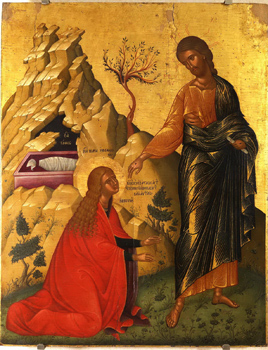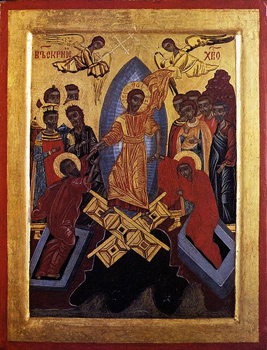For Sunday April 1, 2018
Lectionary Essay for Easter Sunday
Lectionary Readings (Revised Common Lectionary, Year B)
Isaiah 25:6-9
Psalm 118:1-2, 14-24
Acts 10:34-43
John 20: 1-18
Over the past two years, I’ve lost two close friends to sudden cardiac death. Both of them were my age when they died — wives and mothers in their mid-forties, active and healthy, with children ranging in age from nine to sixteen. Both deaths came with no warning, no symptoms, no time. No time to say goodbye, no time for a final embrace. One minute they were alive and thriving in the world, and the next, they were gone.
In the days, weeks, and months that followed each death, I flailed. I grieved for the husband and children each friend left behind. I experienced panic attacks. I slept poorly. Most of all, I raged at the randomness of it all, the futility and unfairness of a world in which stories — beautiful, rich, layered life stories — get cut off mid-sentence without sense or explanation. These friends of mine were hopeful and vivacious women. They wanted to see their children graduate from high school and college. They looked forward to planning their daughters’ weddings, and welcoming grandchildren into their arms. They wanted to celebrate silver and golden anniversaries with their spouses. They wanted to write, teach, worship, celebrate, love, laugh, dance, serve, travel, explore, LIVE. They wanted to live.
I know that I write these words from a position of privilege; I made it through four decades of my life before death hit unbearably close to home. I’m well aware that there are babies whose mothers exit this world just as they enter it. Parents who lose their toddlers to cancer or their school-aged kids to gun violence. Men, women, and children around the world who regularly confront death from starvation, terrorism, war, disease, poverty, abuse, neglect, crime, or natural disaster. My experience of loss is neither unique nor dramatic; it is the human condition. As an 8th century Gregorian chant puts it, “In the midst of life, we are in death.”
 |
This week, the Church celebrates Easter, the highpoint of our liturgical year. With trumpets, with choirs, with candles, Easter lilies, and “Alleluia” banners, we proclaim the great triumph of Christ’s resurrection. The wilderness of Lent is behind us. The tomb is empty and a bright, new day has dawned. “He is Risen! He is Risen, indeed!”
I believe these words with all my heart, and I will say them as enthusiastically as I can on Sunday morning. But this year, as I continue to grieve the deaths of my friends, I am drawn more urgently to other aspects of the Easter narrative. I am drawn to what Frederick Beuchner calls “the darkness of the resurrection itself, that morning when it was hard to be sure what you were seeing.” As our Gospel reading from St. John describes it, the disciples stumbled around in the half-light on that third day after Jesus’s crucifixion, running here and there in their confusion. Was it an angel, sitting in that unlit tomb? Were those shadows grave clothes? The stranger lingering outside — was he the gardener? “Early in the morning, while it was still dark…” That’s where Easter begins. It begins in the dark.
When I was growing up, the key Easter fact to proclaim was that Jesus rose — physically, bodily, literally — from the dead. As long as I believed in the historicity of the resurrection, I was safe. Later, as an adult, I encountered other versions of the Easter narrative. The resurrection was a metaphor in these versions — not a literal historical fact, but a potent symbol of transformation, renewal, and rebirth. Whether or not Jesus physically rose again didn’t matter — his friends and followers experienced his continued presence, and that was enough.
The fact is, the resurrection happened in total darkness. Sometime in the predawn hours of that Sunday morning, a great mystery transpired in secret. No sunlight illuminated the event. No human being witnessed it. And even now, two thousand years later, no human narrative can contain it. It exceeds all of our attempts to pin it down, because it’s a mystery known only to God. Whatever the resurrection was and is — physical, literal, metaphorical, symbolic — its fullness lies in holy darkness, shielded from our eyes. All we can know is that somehow, in an ancient tomb on a starry night, God worked in secret to bring life out of death. Somehow, in the utter darkness, God saved the world.
| |
Earlier in my life, this ambiguity would have frustrated me. Now it doesn’t; it seems exactly right. Why? Because what I have learned in the process of grieving my friends’ deaths is that no story my tiny mind can contain would be big enough to redeem such catastrophic loss. Death is such an abyss, such a horror, such a violation — that nothing I can understand or explain will make it okay. Only a mystery as huge as the resurrection will suffice. Only my faith that God will somehow complete every story death interrupts, gives me solace. Having seen death up close, I cannot rest in certainty any longer — certainty isn’t enough. I can only rest in mystery. My grief can only bear fruit in the dark.
In our Gospel story, Mary Magdalene sees Jesus first because she chooses to remain in the darkness. Peter and John leave when they see the empty tomb, but Mary stays, bewildered and bereft. As Nadia Bolz Weber puts it, she “remains present to what is real, what is actually happening.” She does so even when what is real feels unbearable.
In my own life, I am finding it increasingly true that clarity, hope, and healing come when I am willing to linger in hard and barren places, places where the usual platitudes fall flat, and all easy answers prove inadequate. Jesus comes in the darkness, and sometimes it takes a long time to recognize him. He doesn’t look the way I expect him to look. He doesn’t let me cling to my old ideas of him. He disappears again just as I grab hold of him. But he comes, he calls my name, and in that instant, I recognize both myself and him.
In a beautiful essay on the resurrection, theologian and writer Chris Barnes reminds us of what actually matters during Holy Week: “The question that Easter asks of us is not, ‘Do we believe in the doctrine of the resurrection?’ Frankly, that is not particularly hard. Our doctrines bend easily to conform to the darkness…. What the Gospels ask is not, ‘Do you believe?’ but ‘Have you encountered the risen Christ?’”
 |
As I continue to struggle with the loss of my friends, what matters isn’t theology — what matters is encounter. What matters is encountering the risen Jesus, and finding in the mystery of his resurrected life the hope I need for my own. Often, it’s only in retrospect, only as I look back at the “gravesides” of my life, that I find the beginnings of new life. Poet R.S. Thomas describes the process this way in his poem, “The Answer”: There have been times/when, after long on my knees/ in a cold chancel, a stone has rolled/from my mind, and I have looked/in and seen the old questions lie/ folded and in a place/by themselves, like the piled/graveclothes of love’s risen body.”
This Easter, may the Christ who rose in the darkness lead us into new life, new light, and new hope. May we know him in the half-lit places, the shadowy places, the hard places. May we dare to linger at the graveside until he calls our names. And may we always share with hope the news of God's greatest mystery. Christ is Risen. He is Risen indeed.
Image credits: (1) pvhc.net; (2) Wikipedia.org; and (3) Wikipedia.org.





